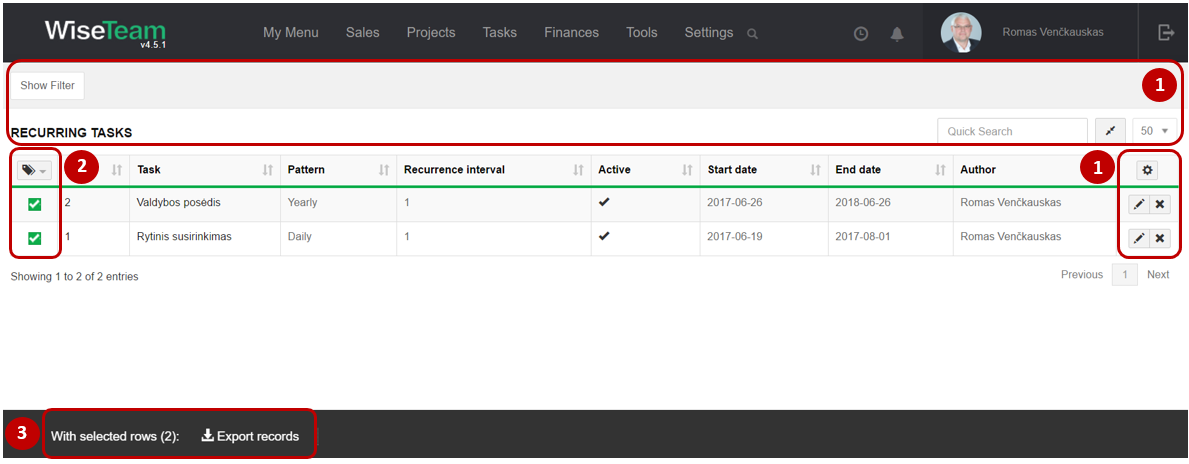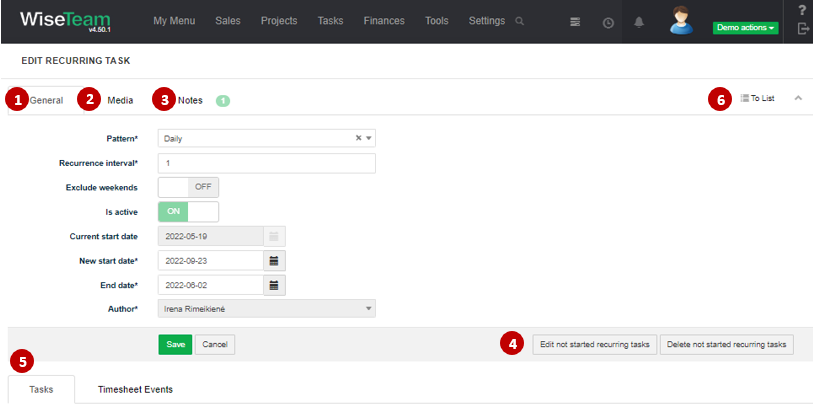If you have a task that will happen every couple of days or every month — any regular schedule — Wiseteam can help you create it as a recurring task, so you only have to set it up once.
Review Recurring Task form
1. General information about Recurring Task is provided in tab General.
2. In tab Media it is possible to attach files. Click Select Files or do Drag & Drop.
3. In tab Notes it is possible to leave notes. Click Add note to create new note.
4. Actions that can be taken with Tasks:
- Edit not started recurring tasks: is used to edit recurring Tasks according to a template task and recurrence information.
- Delete not started recurring tasks: is used to delete generated recurring Tasks which status is Not started.
5. Available Info Tabs:
- Tasks: recurring task list.
- Timesheet Events: allows seeing Timesheet records related to this Task.
6. Available navigation buttons:
- To list: is used to go to the list of Tasks.
Create new Task
To create a recurrring Task create a Task in Tasks list, Kanban or form or list of the related object and define recurrence information:
1. In the list of Tasks click![]() , in Kanban window click
, in Kanban window click ![]() or in the form of related object (tab Tasks) click
or in the form of related object (tab Tasks) click ![]() .
.
2. Fill in Task information:
- Task: title of the task.
- Related to: task relation to either of categories: Project, Activity, Acceptance Certificate, Campaign, Expense, Incident, Invoice, Invoice Proforma, Issue, Lead, Opportunity, Payment, Problem, Purchase, Risk, Change.
- Planned start: planned date and time to begin the task. Planned event in Timesheets is created when Task has planned start time.
- Planned finish: planned date and time to end the task.Planned event in Timesheets is created when Task has planned finish time. Owner time availability is checked when Task has start and finish times.
- Tentative: enable if defined planned start and finish dates are tentative.
- All day: enable if it is all day Task.
- Owner: user, who will receive the task.
- Planned work, h: approximate time required to perform the task. If planned start and finish are provided, calculated automatically.
- Single time record: enabled automatically when task start and finish time is defined. When this setting is enabled only one Time record related to the Task is and can be created.
- Type: category of planned task (list is taken from Settings → Dictionary → Task → Type). If task type is Meeting and task is assigned to other users using “Meeting with”, then related tasks are created for the owner of the task and for the users from “Meeting with” field. In case changes are made in any of these tasks, they reflect in all the related tasks. There is also a possibility to define which Task types can be used to generate meeting Tasks by adding a tag “meeting” to the Task type in Settings → Dictionary → Task → Type.
- Priority: importance or necessity of the task (list is taken from Settings → Dictionary → Task → Priority).
- Location: location where the is executed. Information of the location is transferred to the Time report and Time records.
- Send meeting request: can be marked while creating the task, sends meeting request to task owner and users added to Meeting with field (email is taken from Settings → Users). Meeting request is sent by email to internal contacts only. External entries are not updated if Meeting Task is changed in WiseTeam afterwards.
- Reminder: define time when Task reminder about an upcoming Task has to be presented. Task reminder will be presented as a notification in WiseTeam and sent to user’s email.
- Follow up: enable to create subsequent task after completion (in Kanban dragged to Done column), with automatically filled information from first task.
- Private Task: enable if you want to prevent other people see details of a particular Task (title, notes, media). Others will be able to see the duration of your Task and entity to which Task is related.
- Contracted work: time contracted with client to perform the task.
- Copy and assign to: add other users to create tasks with the same information and assign to them.
- Meeting with: add users and Contacts who are attending the same meeting to create tasks with the same information and assign to them. These tasks will be related to each other and the information of one task will be updated automatically in case changes in related Task are made (including changing Task status).
- Add Note / Media: after clicking +Add Note / Media you will be able to leave notes about the Task or attach media files.
3. Fill in Task recurrence information:
- Pattern: Task recurrence pattern (daily, weekly, monthly, yearly)
- Recurrence interval: Task recurrence interval.
- Exclude weekends: enable this option if you want exclude weekends.
- Weekdays: select weekdays when task has to be created. This option is available
- End date: end of the recurrence.
3. Click Save.

Perform actions in the list of Recurring Tasks

1. As in all lists, you can work with Tasks by using standard functionality buttons: filter Recurring Tasks, add new Task, change table properties, search Recurring Tasks, narrow or extend information viewable in table cells, edit or add additional information to the Recurring Task, delete Recurring Task from the list.
3. It is possible to perform actions with Tasks in the list without opening the entries. After selecting single or multiple Tasks by marking lines ![]() or selecting all Tasks by clicking
or selecting all Tasks by clicking ![]() button there is a possibility to selected Recurring Tasks to MS Excel file.
button there is a possibility to selected Recurring Tasks to MS Excel file.
